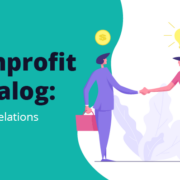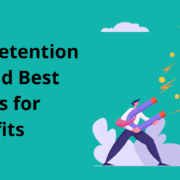The Role of a Nonprofit CRM in Personalized Fundraising
What would you say if someone were to ask you, “What goes into a successful fundraising campaign?”
Drawing on your experience as a nonprofit leader, you might talk about having clear goals, coming up with unique campaign ideas, or using storytelling best practices in your marketing materials.
While it’s true that all of these strategies are important, the groundwork for fundraising success is laid long before you ever start designing a campaign. True fundraising success stems from knowing and understanding your donors, which allows you to personalize the fundraising experience.
That’s where a robust constituent relationship management (CRM) system comes into play. In this mini guide, we’ll dig deeper into the role your CRM can play in personalized fundraising. Let’s begin.
Understanding Nonprofit CRMs
Also known as a donor database, a CRM is a software tool that helps your organization manage its relationships and interactions with its supporters, including donors, volunteers, members, and others.
Though every system has different features, typically a CRM allows you to:
- Store and manage donor data like giving history, personal details, and contact information
- Process donations
- Track grants and grant applications
- Automate and manage communications with supporters
- Generate reports that allow you to visualize your organization’s performance
- Manage and coordinate volunteer activities
Many CRMs can also integrate with other software tools, like your social media profiles, email marketing software, product fundraising platforms, and financial tools, allowing you to manage several aspects of your operations simultaneously.
There are several popular CRM platforms, but Blackbaud and Salesforce are particularly popular providers. Here’s a little bit about each:
- Salesforce primarily offers CRM tools to for-profit organizations but also provides robust tools to the mission-driven space. Its primary solutions are:
- Salesforce Nonprofit Success Pack (NPSP), a series of packages that can be installed on the main Salesforce platform to make the tool useful for nonprofits
- Nonprofit Cloud, Salesforce’s newest cloud-based solution for nonprofits that allows users to connect with other Salesforce Industry Clouds
Both tools are highly customizable solutions for mid-sized, large, and enterprise-sized organizations, but they take a little more know-how to get up and running with them.
- Blackbaud works exclusively with social good organizations like nonprofits. It offers several CRM platforms:
- eTapestry, for small organizations
- Raiser’s Edge NXT (RE NXT), for mid-sized to large organizations
- Blackbaud CRM (BBCRM), for enterprise-sized organizations
Whether you choose to go with RE NXT or Nonprofit Cloud, or even turn to another software provider, depends on your needs. Take into consideration the features your organization wants and your budget as you start the shopping process.
Now that you know the basics of nonprofit CRMs, let’s explore two ways your CRM can help you create a more personal experience for the supporters you’re targeting with your fundraising campaign.
1. Managing Donor Data
Your CRM allows you to capture, store, and manage your donor data in dedicated donor profiles. Your team can then review the data and note specific trends and patterns, which can inform your fundraisers.
For instance, you might notice that your mid-level donors often increase their contributions after attending a fundraising event. You could then plan more events into your fundraising strategy and tailor them to your mid-level donors’ interests and preferences.
To ensure the data in your CRM is primed to provide useful insights like these, practice good nonprofit data hygiene. Here are a few tips for doing so:
- Remove unnecessary information, like contact information for deceased individuals, incarcerated individuals (who cannot respond to marketing materials), minors, and individuals on do-not-call or do-not-mail lists.
- Get rid of duplicate entries in your database.
- Standardize how data is input into your CRM, like the formatting that addresses and dates should follow.
- Verify phone numbers and email addresses.
- Invest in data append services to supplement your own data-gathering efforts.
Prioritizing data hygiene is key to getting the most out of your data and the many fundraising features your CRM has to offer. As you set your standards for how data is collected, formatted, and updated, ensure you train your team so that everyone is on the same page and can help you maintain high-quality data.
2. Tailoring Donor Outreach
After you’ve studied your data to get a better understanding of your donors and their needs, preferences, and interests, you can put that information into action for your fundraising outreach efforts.
One of the best ways to do this is to practice thorough segmentation. Segmentation is the process of sorting your donors into groups based on their shared characteristics. Here are some common characteristics you can sort your donors by:
- Age Group
- Geographic Location
- Giving Level
- Donation Frequency
- Engagement Level
Say you decide to sort your donors by geographic location. You would then use different outreach strategies for the different groups you create.
For example, you could invite donors who live in the city or state where your organization is headquartered to attend an in-person event or adjust your fundraising marketing materials to talk about how their donations will affect beneficiaries in their local area.
For donors who live out of state or even in other countries, you could promote virtual engagement opportunities and communicate the broader, long-lasting impact of their support for your global initiatives.
This way, you ensure your outreach resonates appropriately with the different groups and their needs instead of settling for a one-size-fits-all approach.
Personalize your outreach efforts further by using details from your CRM to make each message feel more catered to the individual. Even simply using a donor’s first name in a donation appeal instead of the generic “Dear Donor” can go a long way to grab their attention and enhance their opinion of your organization and its campaigns.
Having a robust CRM on your side can benefit several aspects of your nonprofit’s operations, but it can be especially useful for personalizing your fundraising efforts. Use the CRM shopping guidance and the personalization tips above to take your next campaign to new heights.
Should you need to upgrade your CRM or expand its functionality through custom integrations, don’t hesitate to reach out to a nonprofit technology consultant. These experts can help you implement the right solution for your organization’s needs.




